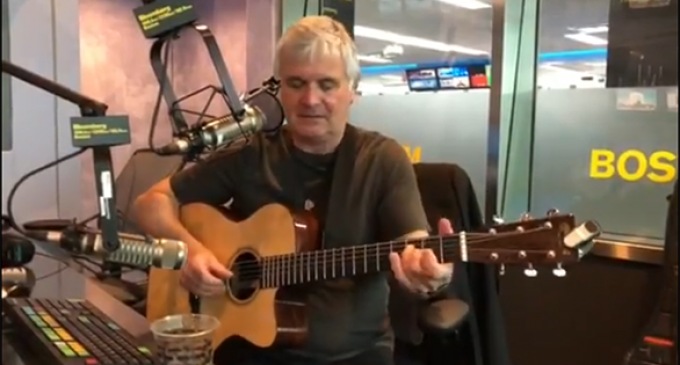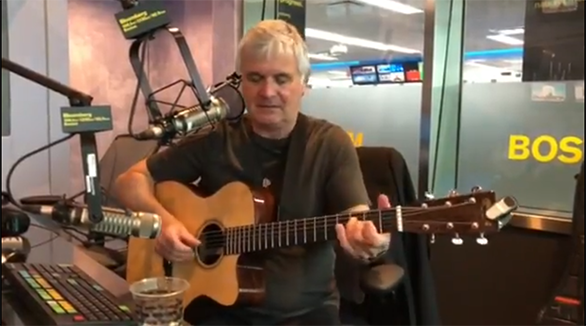Laurence Juber Rules the ‘Realm of the Tune’ – The Syncopated Times

My television was on, but I wasn’t watching—until the talent of Laurence Juber demanded my attention. His finger style guitar playing was stunning. My ears were both delighted and confused, certainly there was a stand-up bass and another guitar being played out of sight.
I had to know more about him so I Googled and discovered an amazing musical journey. His credits are too numerous to list in their entirety, but here are a few of the highlights. Two time Grammy winner, (second was for best pop solo guitar arrangement of Henry Mancini’s Pink Panther Theme). Lead guitarist for Paul McCartney and Wings. In demand studio musician, composer, and arranger who has contributed to a great deal of television and film. In the prestigious and iconic category he played The James Bond Theme for the 007 film The Spy Who Loved Me. He was voted one of the best acoustic guitarists of all time by Acoustic Guitar Magazine. His sideman duties includes working with such legends as Cleo Lane and Charles Aznavour.
I knew none of that when I heard him playing “I Can’t Give You Anything But Love” on television. As luck would have it he was doing a rare one-off solo show the next night in Los Angeles. I wrote and asked if I could interview him after his show.
Born and raised in London, England he now lives in Los Angeles.
Laurence’s fans and friends call him L.J. That might be the only shortcut this musician has ever embraced. He is a methodical artist. He has studied and been influenced by so many different types of music he himself won’t be put into a category. “I am a musician. I tend not to compartmentalize.” His goal was always to be a studio musician, and the most successful ones are multi-dimensional players. He plays acoustic guitar, electric guitar, and bass. By the time he graduated from London University he added lute to the mix.
The first stirrings of his musical future was when a cousin played him Buddy Holly and Elvis records. When he was nine years old and able to manage his own records, The Beatles were just starting to hit. Beatlemania was in full bloom in November of 1963 and this coincided with his 11th birthday. He asked for and received his first guitar. “Once I picked it up I never put it down.” The goal at 11 and going forward was to become a session musician. Mostly self-taught he learned music notation and sight reading from a book called Play in a Day. He tried to acquiesce to his father’s desire to have a saxophone player in the family by signing up for the instrument at school. His name was so far down on the list that by the time his name was called there were no more saxophones left.
The continued success of The Beatles along with the rising folk movement gave the guitar a more prominent place is popular music and a new legitimacy. That helped Dad get over the loss of a reed player.
L.J. pointed out that in those days there was a lot of great guitarists but no internet. “You just put the record on and put it down to 16 rpm and figured out what the notes were.”
By the age of 13 he was recruited by a local bandleader and was playing professionally at weddings. At one of those first gigs, the bass player leaned over and said “Listen lad, if you don’t know the chords just play the bridge of ‘I’ve Got Rhythm.’” The circle of fifths would save him. He credits those pubescent gigs as the biggest part of his ear training.
The next goal was to be in London’s National Youth Jazz Orchestra. At that time it was the farm team for session players. They handpicked the best of the lot to work on studio projects. Simultaneously he decided he wanted to continue his formal education and went to London University to study Music and Musicology.
“Because I really wanted to understand the basis of style, I consider myself a guitarologist because I wanted to understand the history of not only the instrument but the music played going back to the Renaissance.”
His first solo albums in the 1990s were all original compositions and one of the most hauntingly beautiful tunes he played when I saw him was an original tune called “Guitar Noir.”
L J Plays the Beatles was his first album of covers. He was no stranger to the tin pan alley cats, as North London’s youngest wedding guitarist those standards were what he cut his teeth on. In the last decade he has started recording more standards. In 2006 he recorded an album of Howard Arlen tunes entitled: I’ve Got the World on Six Strings.
His newest album Downtown has 14 tracks; 12 are from the American Songbook. One of the non-jazz tracks is the album’s namesake tune and a pop classic, “Downtown” (the 1964 international hit, written by Tony Hatch performed by Petula Clark). Juber’s rendition is so intoxicating that I had to listen to it three times back to back. (I will admit some bias here, as that tune is one of my earliest music memories—a favorite tune of my Mother for over a decade it became imprinted on me as a toddler.) The rest of the record includes classic jazz standards such as: “Caravan,” “Limehouse Blues,” “The Sunny Side of the Street,” and “I Can’t Give You Anything But Love.” He bends the tunes to his will; they feel fresh but in no way does he forget what made them classics. In fact one of L J’s buddies is Lee Newman, the grandson of Jimmy McHugh.
We spoke about his ability to add his own stamp on a tune but never lose the tune’s essence.
“While there can be indulgence in jazz, the greatest jazz players exist in the realm of the tune….not just stringing a bunch of licks together.
“My approach is very much a vertical approach. What’s happening on one beat to the next. What’s the bass doing, what’s the melody doing….the musical information of a song is primary…working to find how a tune fits on a guitar in a way that is pleasing to me.”
One of the ways L.J. is able to accomplish this is his use of DADGA tuning. He is able to achieve things he can’t do in regular tuning. The open D and A strings allow him a certain freedom and he uses those open strings to give the tune another kind of “texture.”
He spent a year and a half on the arrangements for this record, then went into Capitol Records and recorded with the legendary recording engineer Al Schmitt. (Schmitt has the most Grammy awards of any mixer or engineer having mixed or recorded 160 gold and platinum albums.) Five hours later Downtown was born.
On the evening I saw L.J. perform he was suffering from bad allergies. It was evident when we sat down to talk, and by a cough that escaped during a tune. The very last song he played was the only song he sang. Now many instrumentalists get away with charming singing without real pipes. Even while he was battling histamines his singing was really fantastic—a tenor belt that lent itself to the classic pop rock song he sang. I asked him why he doesn’t sing more.
“I’m starting to sing more. My problem is I can never remember lyrics, but now I can put them on my Ipad…I made a decision a long time ago that I wanted to be the best guitarist I can be. Which meant not spending half my time being a singer.”
His plan worked.
All things Laurence Juber can be found on his website LaurenceJuber.com. His music is available for purchase on iTunes.
Source: Laurence Juber Rules the ‘Realm of the Tune’ – The Syncopated Times




There are no comments at the moment, do you want to add one?
Write a comment